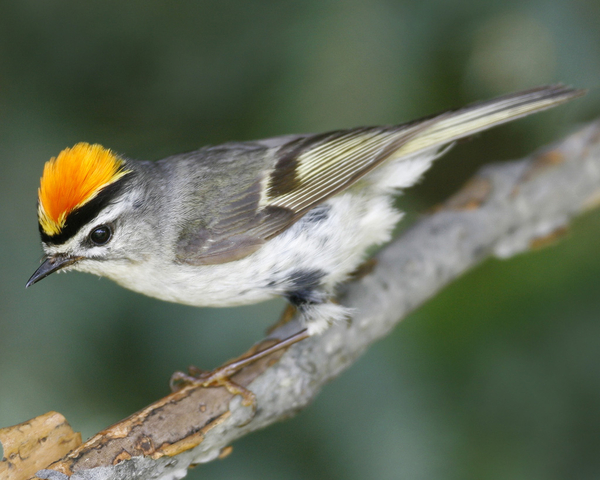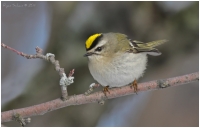The Golden-crowned Kinglet is a fidgety active bird, which often hangs upside down and hovers to glean insects off trees. It has a short, forked tail and barred wings which constantly flick as the bird moves around. The song is a sweet, high-pitched accelerating trill w hich is inaudible to some. Its call is a series of high, thin zee zee zee notes.
hich is inaudible to some. Its call is a series of high, thin zee zee zee notes.
The stocky little Golden-crowned can be found breeding in northern Wisconsin in dense boreal forests. Wintering birds and migrants are less particular and will use a variety of habitats. This insect eater will also occasionally feed in weedy habitats.
The Golden-crowned Kinglet prefers to hang out with like birds in small groups. They make their nests of lichens, spiderwebs, bark and other fine materials such as feathers and fur. They lay between 3-11 eggs in a deep, cup-like nest. Incredibly, they are able to raise two large broods in a short nesting season. The mother feeds her young for only one day after they fledge the nest. The fledglings are then left to fend for themselves as the mother readies her nest for the next clutch.

- Don't let its dimunitive stature fool you. This humingbird-sized bird has a feisty personality. Observers approaching too closely will be verbally scolded while the bird fluffs its feathers and raises its crown in anger.
- Each of the Golden-crowned Kiglet's nostrils are covered with a single tiny hair.
- The Golden-crowned Kinglet can winter as far north as Alaska.
- The Golden-crowned male contributes to parental care. He not only feeds all of the young in the large brood but occasionally feeds the incubating mother too.
- The oldest known wild Golden-crowned kinglet lived to be a little over 5 years old.
* This article was written using facts from the National Geographic, Field Guide to the Birds of North America, Richard Crossley's, The Crossley ID Guide: Eastern Birds, the Cornell Lab of Ornithology website, allaboutbirds.org, and the iPhone app, iBird Plus.





